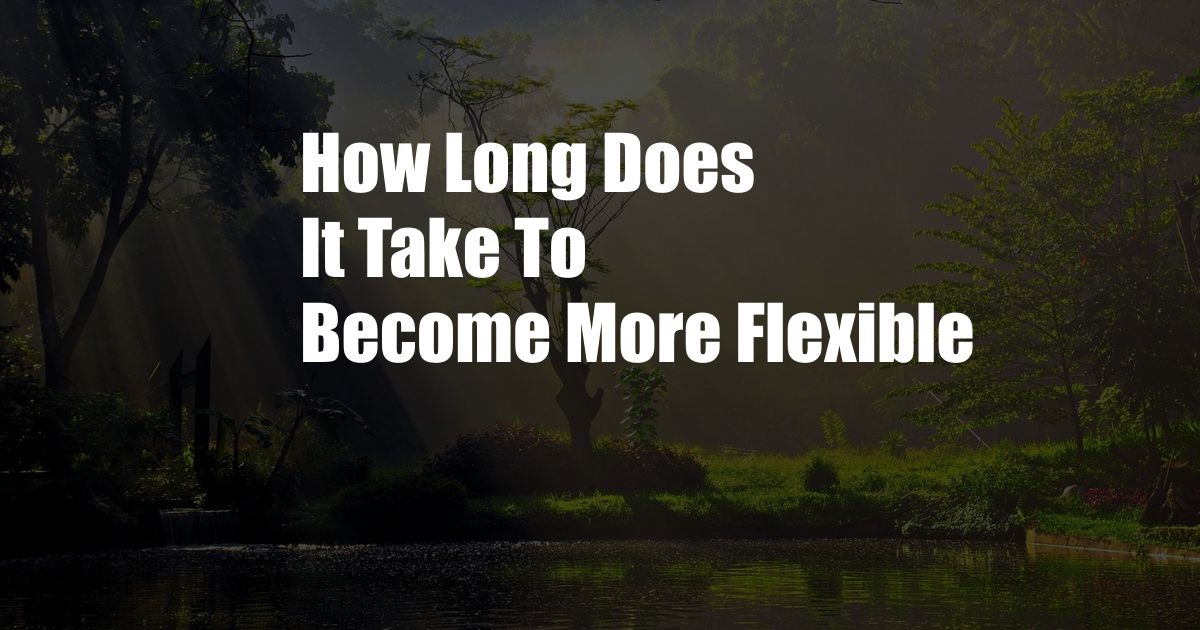
How Long Does It Take to Become More Flexible?
“I’ve always been the stiffest person in my yoga class,” I thought to myself as I struggled to touch my toes. “Will I ever be able to do a backbend?”
As someone who has grappled with inflexibility for as long as I could remember, I was determined to find out how long it would take to become more limber. Little did I know, my journey to becoming more flexible would be more complex than I had initially imagined.
What is Flexibility?
Flexibility, in the context of human movement, refers to the range of motion around a joint. It encompasses both active and passive flexibility, with the former involving voluntary muscular control and the latter relying on external forces.
Several factors influence flexibility, including age, gender, genetics, and activity level. Generally, younger individuals tend to be more flexible than older adults as their connective tissues are more supple. Women are also typically more flexible than men due to hormonal differences that affect muscle elasticity.
How to Become More Flexible
Improving flexibility requires patience, consistency, and a holistic approach that encompasses both physical and mental aspects. Here are some effective strategies to enhance your range of motion:
1. Dynamic Stretching: Dynamic stretches involve active movements that gradually increase the range of motion around a joint. They warm up muscles and prepare them for more intensive stretching exercises. Examples include arm circles, leg swings, and torso twists.
2. Static Stretching: Static stretches hold a position for an extended period (usually 15-30 seconds) to lengthen muscles. This type of stretching is most effective after a warm-up or workout when muscles are warm and pliable.
3. Active Isolated Stretching: This technique involves isolating specific muscles and gently stretching them to their full range of motion while using a partner or props for support. It effectively targets tight areas and promotes greater flexibility.
4. Yoga and Pilates: These mind-body practices incorporate stretching, strengthening, and balance exercises that promote overall flexibility and body awareness.
5. Massage: Massage therapy can help release muscle tension, improve circulation, and reduce stiffness. It can be particularly beneficial for individuals with chronic tightness or muscle imbalances.
Expert Tips
1. Set Realistic Goals: Don’t try to become a contortionist overnight. Start with small, achievable goals and gradually increase the intensity and duration of your stretching routines.
2. Be Patient: Flexibility improvement takes time and consistency. Don’t get discouraged if you don’t see results immediately. Stick with your stretching program and you will eventually notice progress.
3. Listen to Your Body: Pay attention to your body’s cues. If a stretch feels painful, stop and consult a healthcare professional or physical therapist.
FAQs
-
Q: How long will it take me to become more flexible?
A: The rate of progress varies significantly depending on your age, fitness level, and flexibility goals. Generally, noticeable improvements can be seen within a few weeks of consistent stretching. -
Q: How often should I stretch?
A: Aim to incorporate flexibility exercises into your routine 2-3 times per week. Stretching for 10-15 minutes each session is sufficient to make progress. -
Q: Is it safe to stretch before a workout?
A: Yes, dynamic stretching before a workout can help prepare muscles for activity and reduce the risk of injury. However, avoid static stretching before a workout as it could compromise muscle strength.
Conclusion
Becoming more flexible is a gradual process that requires dedication and a holistic approach. By incorporating dynamic and static stretching techniques, practicing yoga or Pilates, receiving massages, and setting realistic goals, you can enhance your range of motion and improve your overall well-being. Remember, flexibility is not about being able to perform extraordinary poses; it’s about living a healthier, more active life free from stiffness and discomfort.
Are you ready to embark on your journey to greater flexibility?